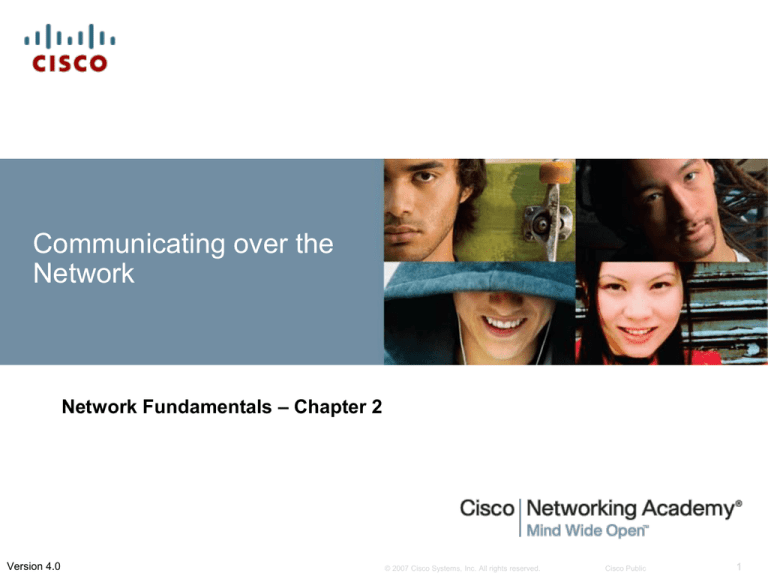
Communicating over the
Network
Network Fundamentals – Chapter 2
Version 4.0
© 2007 Cisco Systems, Inc. All rights reserved.
Cisco Public
1
What will we Learn from chapter 2?
Describe the structure of a network
Explain the function of protocols.
Explain the advantages of using a layered model .
Describe the role of each layer In the:
TCP/IP model
OSI model.
Describe the importance of addressing and naming
schemes.
© 2007 Cisco Systems, Inc. All rights reserved.
Cisco Public
2
Network Structure
Elements of communication
• Message source
• The channel
• Message destination
– Networks carrying different types of messages:
– Data, voice, video, images
© 2007 Cisco Systems, Inc. All rights reserved.
Cisco Public
3
Network Structure
How messages are transmitted
– Messages are sent across a network in small “chunks” called
segments, packets, frames, cells…
© 2007 Cisco Systems, Inc. All rights reserved.
Cisco Public
4
Network Structure
Components of a network
• Hardware
• Software
© 2007 Cisco Systems, Inc. All rights reserved.
Cisco Public
5
Network Structure
End Devices
– Interface with humans or other devices
– Role of end devices:
•
•
•
•
Client
Server
Printers, routers…
Any terminating
networking
device
© 2007 Cisco Systems, Inc. All rights reserved.
Cisco Public
6
Network Structure
Intermediary devices in contrasted to the role of end
devices
• Provides connectivity and ensures data flows
through the and across network
© 2007 Cisco Systems, Inc. All rights reserved.
Cisco Public
7
Network Structure
What is network media?
The path or channel over which a message travels
What are the criteria for making media choice?
© 2007 Cisco Systems, Inc. All rights reserved.
Cisco Public
8
Network Types
Local Area Network (LAN)
– A network serving a home, building or campus may be
considered a Local Area Network (LAN)
© 2007 Cisco Systems, Inc. All rights reserved.
Cisco Public
9
Network Types
Wide Area Networks (WANs)
– Specialize networks connecting LANs, MANs, PANs…
© 2007 Cisco Systems, Inc. All rights reserved.
Cisco Public
10
Network Types
What is the Internet
– A global mesh of interconnected networks (WANs, MANs,
LANs, PANs…
© 2007 Cisco Systems, Inc. All rights reserved.
Cisco Public
11
Network Types
Symbols used to represent network devices and media
© 2007 Cisco Systems, Inc. All rights reserved.
Cisco Public
12
Function of Protocol in Network Communication
Protocol
– A set of rules
© 2007 Cisco Systems, Inc. All rights reserved.
Cisco Public
13
Function of Protocol in Network Communication
Network protocols are used to govern communicate between
devices
© 2007 Cisco Systems, Inc. All rights reserved.
Cisco Public
14
Function of Protocol in Network Communication
Industry standards
– A process or protocols that has been endorsed by the
networking industry and ratified by a standards organization
© 2007 Cisco Systems, Inc. All rights reserved.
Cisco Public
15
Function of Protocol in Network Communication
Technology independent Protocols
– Diverse types of devices can interact using standard sets of
protocols
– Network protocols specify network functionality, not the
underlying device technology
© 2007 Cisco Systems, Inc. All rights reserved.
Cisco Public
16
Layers within the OSI and TCP/IP Reference
Models
The benefits of a layered model
•
•
•
•
Aids in protocol design
Provides for corporate competition
Changes in one layer do not affect other layers
Provides for standard interfaces between devices
© 2007 Cisco Systems, Inc. All rights reserved.
Cisco Public
17
Layers with TCP/IP and OSI Model
© 2007 Cisco Systems, Inc. All rights reserved.
Cisco Public
18
Layers with TCP/IP and OSI Model
The Communication Process
© 2007 Cisco Systems, Inc. All rights reserved.
Cisco Public
19
Layers with TCP/IP and OSI Model
Protocol Data Units (PDU) and encapsulation
© 2007 Cisco Systems, Inc. All rights reserved.
Cisco Public
20
Layers with TCP/IP and OSI Model
Process of sending and receiving messages
© 2007 Cisco Systems, Inc. All rights reserved.
Cisco Public
21
Layers with TCP/IP and OSI Model
– A protocol model provides a model that closely matches
the structure of a particular protocol suite
– A reference model provides a common reference for
maintaining consistency within all types of network
protocols and services
© 2007 Cisco Systems, Inc. All rights reserved.
Cisco Public
22
Layers with TCP/IP and OSI Model
OSI Reference Model
© 2007 Cisco Systems, Inc. All rights reserved.
Cisco Public
23
Layers with TCP/IP and OSI Model
OSI and TCP/IP model
© 2007 Cisco Systems, Inc. All rights reserved.
Cisco Public
24
Addressing and Naming Schemes
How labels in encapsulation headers are used to manage
communication in data networks
© 2007 Cisco Systems, Inc. All rights reserved.
Cisco Public
25
Addressing and Naming Schemes
Ethernet MAC Addresses, IP Addresses, and TCP/UDP
Port numbers
© 2007 Cisco Systems, Inc. All rights reserved.
Cisco Public
26
Addressing and Naming Schemes
How labels in encapsulation headers are used to manage
communication
© 2007 Cisco Systems, Inc. All rights reserved.
Cisco Public
27
Addressing and Naming Schemes
How information in the encapsulated header is used to
identify the source and destination processes for
communication
© 2007 Cisco Systems, Inc. All rights reserved.
Cisco Public
28
What did I Learn from Chapter 2
Describe the structure of a network
Explain the function of protocols.
Explain the advantages of using a layered model .
Describe the role of each layer In the:
TCP/IP model
OSI model.
Describe the importance of addressing and naming
schemes.
© 2007 Cisco Systems, Inc. All rights reserved.
Cisco Public
29
Communicating over the Network
Next
Application Layer Functionality and Protocols
© 2007 Cisco Systems, Inc. All rights reserved.
Cisco Public
30




